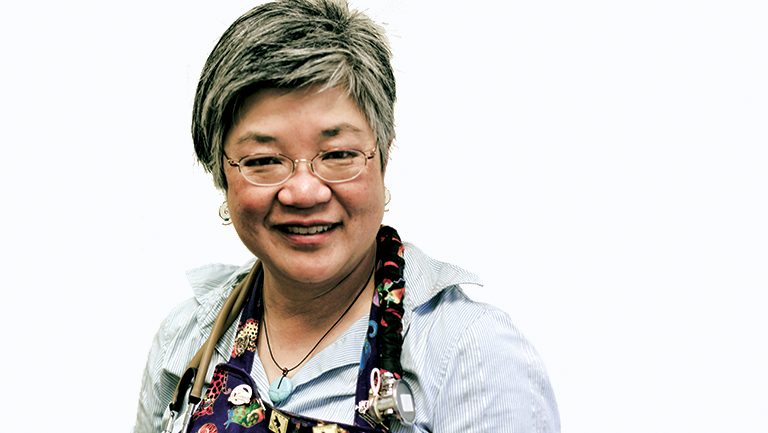 I was born in Boston and moved to the D.C. area when I was four. I was a psych major at the college, pre med and a bio minor. Medicine attracted me because I always loved science and working with people.
I was born in Boston and moved to the D.C. area when I was four. I was a psych major at the college, pre med and a bio minor. Medicine attracted me because I always loved science and working with people.
I met my husband Richard Heather (M’80) on the first day of medical school. He sat in front of me and asked to borrow a pencil for a reading test.

After a long lecture explaining EKGs, our professor asked if there were any questions. One brave student raised his hand and said, “Uh, can you just repeat that whole thing?”
The lectures from Proctor Harvey on cardiology and auscultation were some of the best. His auscultatory lectures with his knuckle sounds stayed with me all through my career.
Our class saw tuition double. As a result, a third of our class joined the military, a third sought help from wealthy family, and a third signed up for the National Health Service Corps like me.
My service corps scholarship got me through medical school without debt. They wanted primary care and they wanted you right out of residency.

I completed my three-year obligation service at a migrant farm worker’s clinic in central Washington, in a small town called Toppenish on the Yakama Indian reservation.
In 1987 I came to San Luis Obispo, California. The population was 30,000, plus Cal-Poly students. Our pediatric practice covered four emergency rooms, phone calls after hours, three nurseries. It was crazy. Things improved when they added a NICU. I retired in 2016.
When I was on call, I’d drive 15 miles on lonely roads to hospitals, sometimes in the middle of the night through dense fog.
Over the years, meningitis, H-flu, rotavirus, and pneumococcal vaccines changed the face of pediatrics and eliminated many of the bad cases we hated to see.

When hospitalists came, it revolutionized our work and cut way back on stress level and worrying about patients at night.
I liked helping children with ADD, asthma, diabetes. My son developed Type 1 diabetes at 9 years old, which was heartbreaking for me.
There’s always pressure to see more patients. With my practice style, I was always behind, never a 30-40 patients a day doc.
Electronic medical records increased my workload. The system creates the need for a scribe, which I didn’t have. I took work home, reconciling billing, finishing notes, responding to messages that I didn’t get to during the day.

My workdays were long. Good thing my husband cooks! He had dinner on the table every day. He is an internist with his own business.
Students have to go through the process themselves to understand why some have advised them not to pursue medicine. You get swept up in the current, you catch the enthusiasm of classmates. It’s a powerful energy. Without that momentum and drive, you won’t make it.
Honestly, I spent a lot my career wondering if this was the thing I was supposed to be doing.

For new doctors, my advice is to take care of yourself: enjoy family, friends, time away. Get help when you’re not feeling well. I’ve had a lot of anxiety and perfectionism–a terrible combination when you do this kind of work. It caused me to worry about patients, take things home in my head. It’s important to set boundaries and not let work engulf you.
Avocations are important, besides occupations. I coach an adapted knitting class at the senior center, am an avid fountain pen user, read Buddhist literature, take tai chi and qigong, and hike as much as I can.

